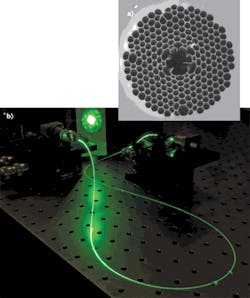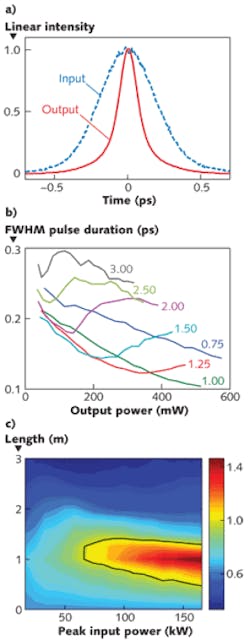
PETER MOSLEY
In the last decade, photonic-crystal fiber (PCF) has revolutionized guided-wave nonlinear optics. The confinement of light by a periodic cladding structure—typically consisting of a regular distribution of air holes within a silica-glass matrix—has allowed unprecedented control over both the linear and nonlinear properties of optical fibers.
Photonic-crystal fiber encompasses a wide variety of fiber configurations, geometries, and guidance mechanisms.1 Highly nonlinear PCF, for example, has a solid silica core in which the light is tightly confined by the high refractive-index contrast with the surrounding air holes. This type of PCF has been phenomenally successful in generating ultrabroadband light known as a supercontinuum. Due to the high fiber nonlinearity, ultrafast pump pulses undergo rapid spectral broadening and a supercontinuum spanning from the edge of the ultraviolet to the near-infrared can be formed.
Fiber nonlinearity
Although highly nonlinear PCF is ideal for generating ultrabroadband light, it is very poor at transmitting high-power ultrafast pulses without distortion due to its nonlinearity. During the supercontinuum-generation process, the resulting widely distributed frequency components are torn apart by dispersion, breaking each pump pulse into several sub-pulses. Although this is an extreme example, the same problem exists in any fiber (be it PCF or conventional step-index fiber) in which the optical mode propagates predominantly in glass because the fiber nonlinearity is tied to that of the bulk medium. Due to the confinement of the mode to a relatively small area, even ultrashort pulses of modest energy will reach high peak intensities and therefore elicit a strong nonlinear response from the fiber. The resulting spectral broadening leads to significant temporal distortion and a commensurate reduction in peak power.
These nonlinear effects limit the efficacy of solid-core fiber in a multitude of applications that require flexible delivery of high-power femtosecond pulses of light—materials processing or nonlinear imaging, for example. One application that is currently generating considerable interest is in vivo nonlinear imaging, particularly microscopy based on coherent anti-Stokes Raman spectroscopy (CARS). These techniques measure the nonlinear response of the sample being illuminated and hence require the delivery of ultrashort pulses at the output of a meter-scale flexible endoscope. Any nonlinear response from the fiber in the endoscope will not only reduce the signal due to the drop in peak power of the pulses at the output, but also create additional noise in the form of new frequency components generated in the fiber rather than at the sample. Hence, this task is not suited to the inherent nonlinearity of solid-core fiber.
Reducing nonlinearity with a hollow core
Photonic crystal fiber can be used to solve this problem by engineering structures in which light is guided almost entirely in a hollow core. In this case, the material refractive index of the core is lower than that of the cladding, and therefore the light must be confined by a mechanism that does not rely on index contrast. Guidance of light in a hollow-core PCF (HC-PCF) was first demonstrated in 1999 at the University of Bath by fabricating a PC structure with a photonic bandgap spanning the wavelength range of interest.2 Due to the interference of multiple reflections at the air/glass interfaces, wavelengths within the bandgap cannot propagate in the cladding. Therefore, these wavelengths are trapped in the core and low-loss guidance is possible over a relatively broad bandwidth—up to 20% of the value of the central transmission wavelength for a state-of-the-art fiber.
This has profound implications for the guidance of high-intensity ultrafast pulses of light. In HC-PCF, more than 99% of the optical mode can be made to propagate in air, leading to a nonlinearity that can be orders of magnitude less than that of solid-core index-guiding fiber. This low nonlinearity allows high-intensity pulses to propagate relatively undistorted through the fiber.
Furthermore, in a bandgap-guiding HC-PCF, the group-velocity dispersion (GVD) is anomalous across most of the transmission window (short wavelengths travel faster than long). This property can be used to compress ultrashort pulses as they propagate along the length of the fiber. The small residual nonlinearity induces a small amount of self-phase modulation (SPM) that generates new frequency components: red-detuned on the leading edge of the pulse and blue-detuned on the trailing edge. Meanwhile, the effect of anomalous dispersion is to move these new components toward the center of the pulse. Therefore, it is possible by a careful juxtaposition of SPM and anomalous GVD to compress ultrashort pulses and also to transmit them almost without distortion in the form of a temporal soliton.Ultrafast pulse propagation
High-power soliton transmission in HC-PCF was first performed at a wavelength of 1500 nm in 2003 by a team at Cornell University.3 This was soon extended to Ti:sapphire wavelengths with a demonstration at 800 nm the following year using a fiber with a core size of about 9 μm and cladding holes slightly larger than 2 μm in diameter.4 However, soliton propagation was not extended into the visible spectral region primarily due to the difficulty of fabricating suitable fiber. The central wavelength that is transmitted by bandgap-guiding fiber is proportional to the period of the cladding; fabricating HC-PCF for 800 nm is challenging but a fiber for the visible must have an even smaller structure. This pushes the limits of what is possible with current PCF fabrication techniques.
Hollow-core PCF is typically fabricated by the stack-and-draw method: The required structure is formed on a macroscopic scale by stacking hundreds of silica capillaries and then the assemblage is drawn down to the final diameter on a fiber-fabrication tower. As the structure is heated and stretched, the holes in the cladding and core must be pressurized to hold them open against the surface tension of the silica, which acts to close them. The pressure that is required to keep a hole open increases as the hole shrinks. Hence, fabricating a structure that guides light at short wavelengths is difficult because as the structure is made smaller any differences in hole size in the cladding are exacerbated, leading to cladding deformation and loss of guidance in the resulting fiber. In addition, soliton propagation requires that the GVD curve be relatively flat and therefore the cladding structure must be very regular.
Visible wavelengths
Despite these challenges, at the University of Bath we have recently demonstrated ultrashort-pulse delivery and soliton-effect compression at visible wavelengths in HC-PCF.5 We fabricated a HC-PCF with a core diameter of 5.6 μm and cladding hole size of less than 1.5 μm, yielding low-loss guidance (less than 1 dB/m loss) of green light (see Fig. 1). By injecting positively chirped pulses at 540 nm, we observed linear pulse compression followed by the formation of a temporal soliton accompanied by further compression. After a 1 m length of fiber, the pulse duration was reduced by almost a factor of three to just over 100 fs, corresponding to a peak power of over 200 kW. The spatial mode of a carefully fabricated HC-PCF can be of very high quality, allowing output pulses to be focused close to the diffraction limit (see Fig. 2). We demonstrated this by using the output pulses from our fiber to inscribe micron-scale features on a copper surface.
This is the first time that the capability of HC-PCF for ultrashort pulse compression and soliton propagation in the visible has been demonstrated. Whether this can be pushed to even shorter wavelengths remains to be seen—certainly the challenges in fabrication are significant. Nevertheless, this new wavelength range further broadens the appeal of this cutting-edge technology.
REFERENCES
1. J.M. Dudley and J.R. Taylor, Nature Photon., 3, 85 (2009).
2. R.F. Cregan et al., Science, 285, 1537 (1999).
3. D.G. Ouzounov et al., Science, 301, 1702 (2003).
4. F. Luan et al., Opt. Exp., 12, 835 (2004).
5. P.J. Mosley et al., Opt. Lett., 35, 3589 (2010).
Peter Mosley is a postdoctoral researcher at the Centre for Photonics and Photonic Materials, University of Bath, Bath, England; e-mail: [email protected]; http://www.bath.ac.uk/physics/groups/cppm.
